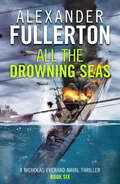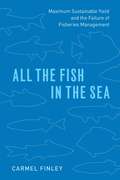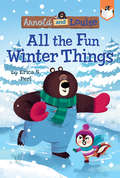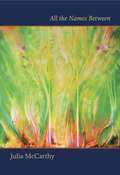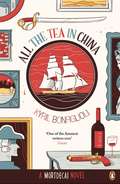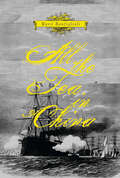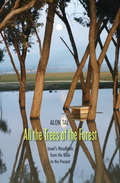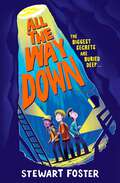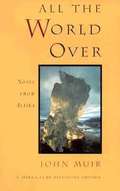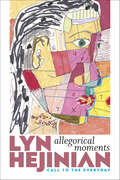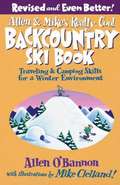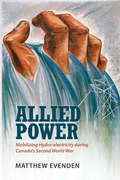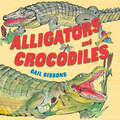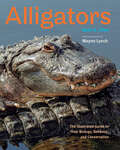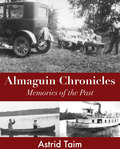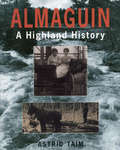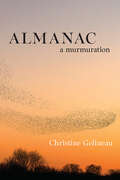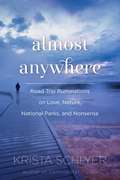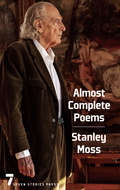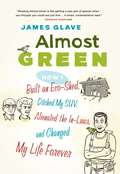- Table View
- List View
All the Drowning Seas: The Nicholas Everard World War Ii Saga Book 3 (Nicholas Everard Naval Thrillers)
by Alexander FullertonThe sixth thrilling instalment of the Nicholas Everard thrillers. 1942. As Japanese invasion fleets sweep across the Pacific, a handful of Allied ships prepare for a last-ditch battle at Surabaya in the Java Sea. Not only is the Allied force doomed to defeat: any surviving ships will be trapped, since escape routes are blocked by the enemy. Nick Everard, commanding the cruiser Defiant, is badly wounded in the battle. His ship is heavily damaged and to make matters worse, he has a battered US destroyer under his protection. But unless Everard can find some way out of the trap, both ships and crews face destruction… All the Drowning Seas presents compelling action at sea, and establishes Alexander Fullerton as one of the premier novelists of naval warfare. Praise for Alexander Fullerton &‘The prose has a real sense of urgency, and so has the theme. The tension rarely slackens.&’ Times Literary Supplement
All the Fish in the Sea: Maximum Sustainable Yield and the Failure of Fisheries Management
by Carmel FinleyBetween 1949 and 1955, the State Department pushed for an international fisheries policy grounded in maximum sustainable yield (MSY). The concept is based on a confidence that scientists can predict, theoretically, the largest catch that can be taken from a species’ stock over an indefinite period. And while it was modified in 1996 with passage of the Sustained Fisheries Act, MSY is still at the heart of modern American fisheries management. As fish populations continue to crash, however, it is clear that MSY is itself not sustainable. Indeed, the concept has been widely criticized by scientists for ignoring several key factors in fisheries management and has led to the devastating collapse of many fisheries. Carmel Finley reveals that the fallibility of MSY lies at its very inception—as a tool of government rather than science. The foundational doctrine of MSY emerged at a time when the US government was using science to promote and transfer Western knowledge and technology, and to ensure that American ships and planes would have free passage through the world’s seas and skies. Finley charts the history of US fisheries science using MSY as her focus, and in particular its application to halibut, tuna, and salmon fisheries. Fish populations the world over are threatened, and All the Fish in the Sea helps to sound warnings of the effect of any management policies divested from science itself.
All the Fun Winter Things #4 (Arnold and Louise)
by Erica S. PerlThere's too much fun to be had in the snow to sleep through the winter season! At least that's what Louise thinks. In this story designed to engage early readers, charming characters combine with simple text, lively illustrations, and laugh-out-loud humor to help boost kids' confidence and create lifelong readers!Snow has fallen and the pond is frozen, so Arnold knows that--as a bear--it's time to hibernate! But Louise insists that he'll miss all the fun winter things if he does, so she convinces him to try hibernating like a chipmunk instead. They'll sleep for a short time, wake up to go sledding or have a snowball fight, and repeat! The only problem is, Arnold can't seem to keep his eyes open. What if he can't stay awake for the winter fun? Exciting, easy-to-read books are the stepping stone a young reader needs to bridge the gap between being a beginner and being fluent.
All the Names Between
by Julie McCarthyPoems that form an eloquent, searching contemplation of “the warp and weft of being and nonbeing.” All the Names Between is Nova Scotia poet Julia McCarthy’s meditative and crackling-with-dark-energy third collection. From her observation of “long-horned beetles... rearranging the landscape” to an apperception of “part of me /...seeded by dust / of meteors and asteroids,” McCarthy makes palpable, in richly layered imagery and with attentiveness that unfolds stillness, the “Singing Emptiness” that informs and quickens the crow’s flight, the stones’ weight, and our own being as we move in “the defined world both elegant / and maimed.” Concerned with both the inadequacy and the necessity of word to convey world, the poems move through a shifting landscape of seasons and creatures, of the remembered dead, and of scattered stones reading the Akashic field. Grounded in the experience of presence, where the external and internal meet, a crossroads of consciousness where “a language without a name / remembers us” and the poem is a votive act, All the Names Between reflects the shadow-light of being, of what is and what isn’t, the seen and the unseen, the forgotten and the remembered where every elegy has an ode at its centreevery ode has an elegy around its edges. (from “Ode with an Elegy around its Edges”) Praise for All the Names Between: “It is Julia McCarthy’s incomparable eloquence as a poet to, as an experienced photographer might, wield darkness as an ever more powerful lens to reveal the intricate beauty of the world as she finds it. And it is with this extraordinary vision, that McCarthy ushers us into her newest collection, All the Names Between, ‘where the dead gather like trees in their white coats’ and bats hover overhead, ‘lucifugal as ashes from invisible fires.’ These are poems scintillate with vision and stunningly intimate—showing us page after page the full, and exquisite measure of ‘night’s worth.’” —Clarise Foster, Editor, Contemporary Verse 2 “Here is a book of meditations for even those immune to poetry, a poetry with no comfort zones. McCarthy takes readers to a world where the marriage between solitude and nature gives birth to memorable, haunting lines, where the mystery of poetry lies just between the words. I have no doubt readers will embrace this book as their own.” —Goran Simić, author of Immigrant Blues and From Sarajevo, with Sorrow
All the Tea in China: A Charlie Mortdecai novel (Mortdecai)
by Kyril BonfiglioliAll the Tea in China - a Mortdecai novel by Kyril Bonfiglioli, soon to be a major film starring Johnny Depp'One of the funniest writers ever' UncutAfter committing a crime anyone but a close relative might forgive, Karli Mortdecai Van Cleef leaves Holland double-quick with his uncle's buckshot lodged firmly in the seat of his breeches. Discretion being the least-idiotic part of valour he decides to hide far away in London, among the tea shops and opium dens. On savouring these Eastern delicacies and knowing an opportunity when he sups upon one, young Karli throws in his lot with an opium clipper bound for China's high seas.Life on the ocean waves, however, is full of perils for an officer and his sensitive digestive tract: mountainous waves, an encounter with a malodorous slave ship, the captain's wife's pulse-racingly brief wardrobe, several hordes of pirates, mutiny, the ship's cook's fondness for curry - to name but a few.All the Tea in China is a swaggering, rip-snorting, buckler-swashing tale about one of the men who - for a reasonable fee - made Britain great.'For those who have learnt to relish his elegant, nasty thrillers, Bonfiglioli is a name hard to forget. This farrago represents a change from the thrillers - a good clean salt-water yarn for the decadent' Irish Press'Shows his customary inventive comedy and zest for language' Sunday Times'Bonfiglioli deserves better than cult status' IndependentKyril Bonfiglioli was born on the south coast of England in 1928 of an English mother and Italo-Slovene father. After studying at Oxford and five years in the army, he took up a career as an art dealer, like his eccentric creation Charlie Mortdecai. He lived in Oxford, Lancashire, Ireland and Jersey, where he died in 1985. He wrote four Charlie Mortdecai novels, and a fifth historical Mortdecai novel (about a distinguished ancestor).
All the Tea in China: A Novel
by Kyril BonfiglioliA Dutchman seeks his fortune in hilarious, ironical, maritime, historical romp that&’s Master and Commander by way of Monty Python. Inspired by a shotgun blast in the seat of his breeches, young Karli Van Cleef quits his native Holland to seek his fortune. He arrives in early Victorian London and soon he is turning a pretty profit. But Karli sees that true opportunity flowers in India&’s fields of opium poppies and the treaty ports of the China coast. So, he takes a berth in an opium clipper hell-bent for the Indies. It is a journey beset with perils. Karli is confronted by the mountainous seas, high-piled plates of curry, and the ferocious penalties of the Articles of War. He survives the malice of the Boers, the hospitality of anthropophagi, and the horrors of Lancashire cooking. En route he acquires some interesting diseases, dangerous friends and enemies, a fortune, and a wife almost as good as new.Praise for All the Tea in China&“Bonfiglioli . . . offers a surfeit of delights in this historical romp, first published in 1978. . . . Bonfiglioli colors his picaresque with an abundance of wit and narrative verve. Indeed, the novel often reads like an unapologetically bawdy Pirates of the Caribbean.&” —Publishers Weekly&“This swashbuckling, mildly ribald adventure will appeal to teens who like historical fiction with a strong plot. With pirates continuing to be popular and the unlikelihood that libraries still own this—or ever did—for teens, young adult collection developers should take note.&” —School Library Journal
All the Trees of the Forest
by Alon TalIn this insightful and provocative book, Alon Tal provides a detailed account of Israeli forests, tracing their history from the Bible to the present, and outlines the effort to transform drylands and degraded soils into prosperous parks, rangelands, and ecosystems. Tal’s description of Israel’s trials and errors, and his exploration of both the environmental history and the current policy dilemmas surrounding that country's forests, will provide valuable lessons in the years to come for other parts of the world seeking to reestablish timberlands.
All the Way Down
by Stewart FosterA life-affirming story about friendship, adventure and self-belief, from the award-winning author of The Bubble Boy. Perfect for fans of Louis Sachar&’s Holes and Elle McNicoll&’s A Kind of Spark. When three eleven-year-old &‘problem children&’ are thrown together at summer camp, they&’re challenged to build a place to live together for the next week. But after a trip to a disused tin-mine goes awry, Milo and his new friends, Oscar and Effie, soon find themselves split off from the group and trapped underground. Can they work through their individual issues and come together as a team to find their way to freedom?
All the World Over: Notes From Alaska
by John MuirMuir explores into the vast and varied splendors of the natural world in Alaska.
Allegorical Moments: Call to the Everyday
by Lyn HejinianAllegorical Moments is a set of essays dedicated to rethinking allegory and arguing for its significance as a creative and critical response to sociopolitical, environmental, and existential turmoil affecting the contemporary world. Traditionally, allegorical interpretation was intended to express an orthodoxy and support an ideology. Hejinian attempts to liberate allegory from its dogmatic usages. Presenting modern and contemporary materials ranging from the novel to poetry to painting and cinema to activist poetry of the Occupy movement, each essay in the book "begins again" with different materials and from different perspectives. Hejinian's generative scholarship looks back to experimental modernism and forward into a future for a vital, wayward poetry resistant to the crushing global effects of neoliberalism.
Allen and Mike's Really Cool Backcountry Ski Book: Traveling and Camping Skills for a Winter Environment
by Allen O'Bannon Mike ClellandAllen & Mike are back with totally updated information and first-hand advice for all aspects of backcountry skiing and winter camping. Learn how to choose the right equipment, avoid hazards such as avalanches and extreme cold, build snow shelters, and have fun while staying safe and minimizing the impact on the wilderness. These two National Outdoor Leadership School instructors offer lots of tried-and-true tricks and useful tips drawn from years of experience.
Alles ist Ökologie
by Mark MaraunDie Idee des Buches ist es zu zeigen, dass Ökologie keine Teildisziplin innerhalb der Naturwissenschaften ist, sondern große Bedeutung für alle Bereiche unseres Lebens hat. Überall wo Organismen interagieren (und das ist ja quasi überall der Fall) gelten die Prinzipien der Ökologie - nur welche sind das überhaupt?
Allied Power
by Matthew EvendenCanada emerged from the Second World War as a hydro-electric superpower. Only the United States generated more hydro power than Canada and only Norway generated more per capita. Allied Power is about how this came to be: the mobilization of Canadian hydro-electricity during the war and the impact of that wartime expansion on Canada's power systems, rivers, and politics.Matthew Evenden argues that the wartime power crisis facilitated an unprecedented expansion of state control over hydro-electric development, boosting the country's generating capacity and making an important material contribution to the Allied war effort at the same time as it exacerbated regional disparities, transformed rivers through dam construction, and changed public attitudes to electricity though power conservation programs.An important contribution to the political, environmental, and economic history of wartime Canada, Allied Power is an innovative examination of a little-known aspect of Canada's Second World War experience.
Alligator Tales: And Crocodiles too
by Miles SmeetonA delightful collection of short poems for children written by a loving grandfather, an ardent voyager, from every port his yacht Tzu Hang put into in the course of his voyages. Fanciful, and sometimes eccentric, thee poems will delight young and old alike. Adults and nature lovers, in particular, will also enjoy the amazing Introduction written by Clio Smeeton, Miles Smeeton's daughter who has a passion for the reintroduction of the swift fox.
Alligator and Crocodile Rescue
by Trish SnyderFrom the Book jacket: Loathed for their dining habits and adored for their skins, alligators and crocodiles were hunted almost to extinction. But thanks to some creative conservation efforts, their status has improved dramatically. Even so, they are still at risk: eight species remain on the endangered list, and some hover on the edge of extinction. In Alligator and Crocodile Rescue, you'll meet people from around the world who are helping to ensure a future for these living links to dinosaurs. Trish Snyder has been an editor at Today's Parent, Chatelaine and House and Home. An award-winning writer, her articles have appeared in Toronto Life, Canadian Business, MoneySense and Glow. Alligator and Crocodile Rescue is her first book.
Alligators (Nature's Children)
by Tim HarrisDescribes the physical features, habits and habitat of the American and Chinese alligator.
Alligators and Crocodiles (Live Oak Media Ereadalong Ser.)
by Gail GibbonsDo you know the difference between alligators and crocodiles...?Alligators and crocodiles are the world's largest reptiles and the closest living relatives of dinosaurs. In this extremely interesting nonfiction picture book, Gibbons compares the two reptiles by giving facts about both--their physical differences, what they eat, where they are found, how fast they swim how they raise their young, and more.Kids will want to read this book again and again to learn all about these crocodilians that have been around for millions of years. A great read-alound for the interested child or non-fiction resource for older children.Drawings are labeled throughout with additional information.
Alligators and Other Crocodilians (World Book's Animals of the World)
by Bari D. FairweatherThis is a fascinating book. Do you know which crocodilian is the smallest? Do you know what Spanish explorers called crocodiles?
Alligators: The Illustrated Guide to Their Biology, Behavior, and Conservation
by Kent A. VlietThe ultimate guide to understanding the biology and behavior of the amazing and underappreciated American alligator.Few scenes put the senses on edge more than a submerged alligator, only eyes and snout showing, when peering across a southern lake on a misty morning. An iconic American predator, these reptiles grow to thirteen feet or more and can live as long as humans. Alligators are complex creatures, capable of terrific attacks and yet tending to their young in the same gentle way a mother duck looks after her brood. Once extremely numerous, alligators came close to extinction in the twentieth century, but thanks to conservation efforts have since made a comeback, reclaiming their rightful place as the monarchs of the southern wetlands.In this fascinating account, richly illustrated with more than 150 photographs from award-winning wildlife photographer Wayne Lynch, expert zoologist Kent A. Vliet introduces readers to the biology, ecology, and natural history of the American alligator. Sharing nuanced depictions of their hidden lives that will forever change the way you think of these giant reptiles, the book• combines captivating storytelling with the most current scientific facts• chronicles the life cycle of the alligator• explains why the alligator's precise anatomy and physiology make it so successful• covers a wide range of topics, from courtship and reproduction to communication, basking, nest-building, and hunting• reveals the alligator's sophisticated social life in detail• evaluates the alligator's environmental role as a keystone species• examines the complicated relationship between alligators and people
Almaguin Chronicles: Memories of the Past
by Astrid TaimThe Almaguin Highlands is a region that was once coveted for its game, silver birch and majestic white pine. For centuries this area stretched up to the shores of Lake Nipissing and embraced an unbroken forest that remained largely intact save where lakes, streams and beaver meadows punctuated the forest floor. In 1900, the northernmost areas of the District of Parry Sound were still not accessible by even a conventional roadway. Homesteaders, their claims precariously strung along the Pickerel River, relied on the waterway as their transportation route. What must it have been like at the outset for the lumbermen who cut down the white pine? And how did the settlers-those intrepid folk who trekked across the district with only the lumberjack’s blazed trails for a guide-cope in the wilderness?Almaguin Chronicles explores the relationship between lumbering and settlement throughout the Parry Sound District-the last frontier of this part of Ontario. Throughout, rare archival photographs and excerpts from unpublished memoirs augment the text.
Almaguin: A Highland History
by Astrid TaimThe Almaguin Highlands, an extensive territory covering a 90 km corridor from Huntsville, north to Callander, west to Dunchurch and east to the Algonquin Park border, is a land rich with lakes, rivers and a lively history. Once considered as a possibility for a government Indian Reserve in the early 1800s, Almaguin became a centre for lumbering and ultimately a year-round mecca for outdoor enthusiasts.Almaguin: A Highland History offers a wide range of stories from the opening of the area by colonization roads to the first vessels on the Magnetawan River and the courage of the early pioneers. Included are community histories of the many towns, villages and ghost towns of today, profiles of colourful personalities, as well as interesting and amusing tales of these rugged early times.
Almanac: A Murmuration (Excelsior Editions)
by Christine GelineauFrom the sanctuary of her one-hundred-and-twenty-acre horse farm in the upper Susquehanna River Valley, essayist and poet Christine Gelineau takes stock of what it means to care for a farm, a nation, a planet—a home—and of how the stories we tell impact our lives.Decades into life on a Morgan horse farm in upstate New York, Almanac author Christine Gelineau focused on the stories we tell ourselves about ourselves and one another, about the planet we all share, and on how these narratives shape our own identities, our communities, and our attitudes and actions toward the environment. Framed by the seasons, Gelineau speaks to these vital conversations about what it can mean to be human in ways that are lyrical, practical, spiritual, and life-affirming. Almanac combines observations of iced-in alligators and newborn foals with prose poems evoking the natural world, gardening techniques learned from the Haudenosaunee, personal resilience in the face of long COVID and brain surgery, and urban versus rural perspectives on water rights and wind-turbine siting. It charts one person's journey into the inner and external worlds that will resonate with all readers dealing with these life-changing times.
Almost Anywhere: Road Trip Ruminations on Love, Nature, National Parks, and Nonsense
by Krista SchlyerWhat do you do when your world ends? At twenty-eight years old, Krista Schlyer sold almost everything she owned and packed the rest of it in a station wagon bound for the American wild. Her two best friends joined her--one a grumpy, grieving introvert, the other a feisty dog--and together they sought out every national park, historic site, forest, and wilderness they could get to before their money ran out or their minds gave in. The journey began as a desperate escape from urban isolation, heartbreak, and despair, but became an adventure beyond imagining. Chronicling their colorful escapade, Almost Anywhere explores the courage, cowardice, and heroics that live in all of us, as well as the life of nature and the nature of life. This eloquent and accessible memoir is at once an immersion in the pain of losing someone particularly close and especially young and a healing journey of a broken life given over to the whimsy and humor of living on the road.
Almost Complete Poems
by Stanley MossMoss is oceanic: his poems rise, crest, crash, and rise again like waves. His voice echoes the boom of the Old Testament, the fluty trill of Greek mythology, and the gongs of Chinese rituals as he writes about love, nature, war, oppression, and the miracle of language. He addresses the God of the Jews, of the Christians, and of the Muslims with awe and familiarity, and chants to lesser gods of his own invention. In every surprising poem, every song to life, beautiful life, Moss, by turns giddy and sorrowful, expresses a sacred sensuality and an earthy holiness. Or putting it another way: here is a mind operating in open air, unimpeded by fashion or forced thematic focus, profoundly catholic in perspective, at once accessible and erudite, inevitably compelling. All of which is to recommend Moss's ability to participate in and control thoroughly these poems while resisting the impulse to center himself in them. This differentiates his beautiful work from much contemporary breast-beating. Moss is an artist who embraces the possibilities of exultation, appreciation, reconciliation, of extreme tenderness. As such he lays down a commitment to a common, worldly morality toward which all beings gravitate.
Almost Green
by James GlaveIn Almost Green, James Glave demonstrates that the journey along the path to a greener life is not always easy but is frequently hilarious and always enlightening. Glave--a writer and stay-at-homedad--describes his experiences building a green writing studio in the front yard of his home on Bowen Island, British Columbia, a not-so-green paradise where SUVs still outnumber compost boxes.While coping with the many frustrations and small victories of this undertaking, Glave also dabbles in grassroots neighborhood activism. He visits a truly green family living in the concrete jungle of the city and decides he must divest himself of his hulking SUV, so generously given to him by his father-in-law, without offending his benefactor.
